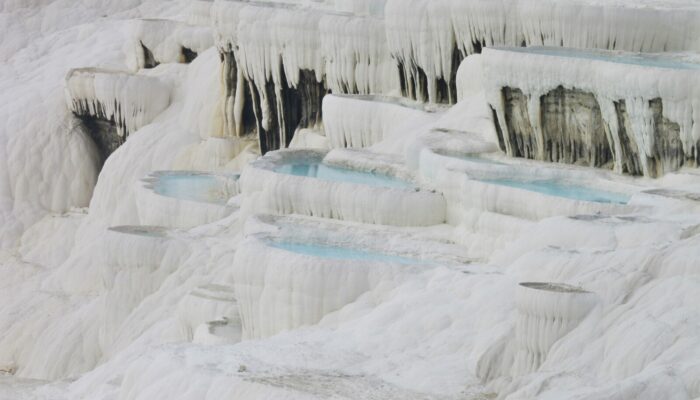
Pamukkale, the cotton castle by Paula Ballikaya. (distributed via imaggeo.egu.eu). Terraces of rock are crowned with the candle wax-like deposits of travertine, the white, fibrous limestone which characterises the Pamukkale UNESCO World Heritage Site and which is featured in the photo above. Despotised and moulded over 400,000 years by the calcite-rich mineral water flowing from the site’s seventeen hot springs, the resulting travertine formation lent itself to the site’s name, Pamukkale, or “cotton castle” in Turkish.
The travertine itself is formed when calcium carbonate minerals dissolved in the water rapidly precipitate, the process by which a dissolved mineral is transformed into a solid. This precipitate is then deposited as a gel-like substance across the slopes by the flowing spring-water, its slow drip forming the white stalactites and terraces seen in the photo.
Pamukkale has attracted visitors for over two millennia. Although iron age settlements have been found in the site, the remains of the ancient city of Hierapolis (“Holy City” in Ancient Greek) evidence how the hot springs were used as spas for centuries from the Phrygians and the Greeks, to the Romans and Persians until the city was abandoned due to conflict and earthquakes.
Whilst Pamukkale’s communities strongly associated the site with health due to the hot springs, it is not the only relationship the human populations had with the environment: it was also known as a gateway to the underworld. Vents in the hill-side disgorge deadly geogenic gases with carbon dioxide levels of some 80%; the regular air we breathe has a carbon dioxide level of 0.04%. The toxic gas released through the Pamukkale fault below was thought to be the breath of Cerberus, the three-headed hound which guarded the gates to the underworld. Here then, as well as spas for wellness, was also built a shrine to Hades, the Greek god of the underworld, where priests would sacrifice animals by tossing them into the deadly gas.
Photo and caption by Paul Ballikaya, shared on imaggeo.egu.eu.
